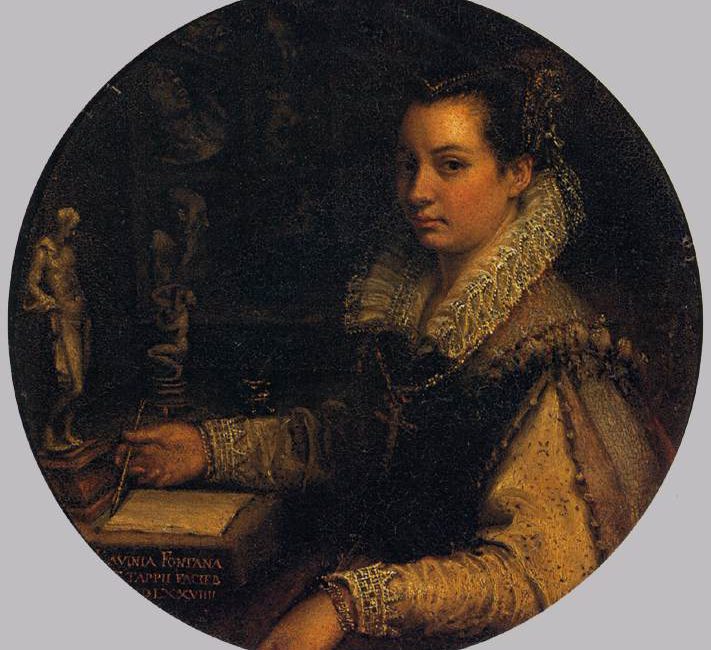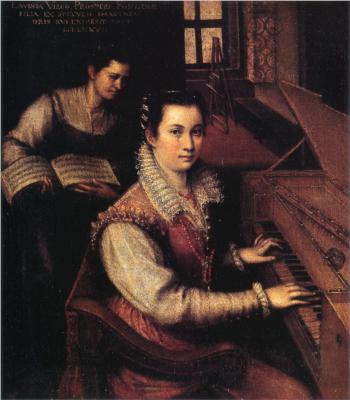
Do you know at least one female artist in Renaissance Europe? Sofonisba Anguissola, Fede Galizia, Artemisia Gentileschi, and so forth. However, so few of the many talented women accomplished a lot in a man-dominated world of the time. One of them is Lavinia Fontana, who was born in Bologna in 1552 to the prominent Bolognese painter Prospero Fontana and his wife, Antonia de’ Bonardis. Becoming one of the most illustrious Renaissance figures, Lavinia lived quite a long life and died in Rome on the 11th of August 1614.
Her father, Prospero, was famous for his frescoes and architectural detailing. He trained and collaborated with many contemporary artists, most of whom were influenced by Raphael’s style. In the 1550s, Prospero traveled to Rome to create the portrait of Pope Julius III, in reward for what he was permitted to work at the pontifical court. At the time, he worked as an assistant to Giorgio Vasari and Taddeo Zuccaro, absolutely admiring Vasari’s style and his painting techniques. For some time, Prospero went to France, where he worked on lavish decorations for Château de Fontainebleau together with Francesco Primaticcio.
Prospero and his wife, Antonia, had two daughters – Emilia and Lavinia. However, Emilia died young, so Prospero focused his attention on his surviving child. Lavinia was not a teenager when she started painting: her first works such as the Holy Family with the Infant Saint John the Baptist and Saint Elizabeth date from the early 1570s, when she was in her early twenties. The above means that Prospero did not originally think of his daughter’s career in the arts, or perhaps he just discovered her talent in her adolescence.
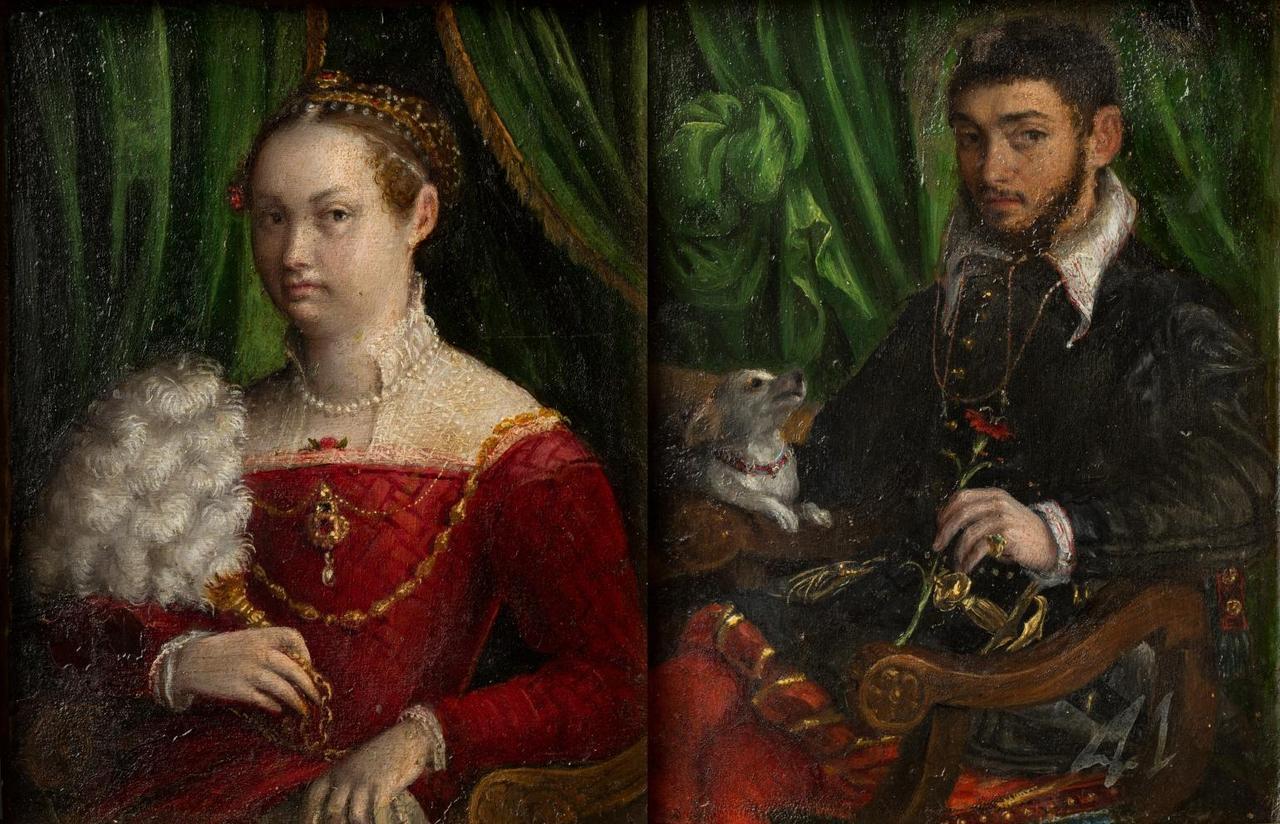
Even though she started painting quite late, Lavinia must have received an education in the arts before. Most likely, teenaged Lavinia studied music, literature, mathematics, and geometry. Prospero was Lavinia’s mentor, teaching her to work in the Mannerism style in his professional workshop. It is interesting that the Italian Baroque painter Artemisia Gentileschi was also taught by her artist father. Lavinia’s early works are stylistically similar to her parent’s: they are small devotionals executed in oil and painted in Prospero’s Mannerist style that is characterized by elongated figures lacking proportions and executed with a masterful sfumato effect. At the same time, they are distinguished from her father’s by her great attention to detail and her outstanding skill to replicate the intricacies of textiles and the decorations of Renaissance clothes.
Prospero understood how difficult it would be for his daughter to build an artistic career. Despite her tremendous talent, Lavinia could obtain fame and earn large commissions only if she looked like a normal woman of the era – if she had a family while also dedicating her life to the arts. With this in mind, Prospero arranged for Lavinia a marriage to his fellow artist and pupil – Gian Paolo Zappi, who was an impoverished minor nobleman from nearby Imola. Prospero foresaw that their union would not narrow his daughter’s world to running her husband’s household and bearing his children, but would encourage her professional career and give her personal happiness.
A practical man, Prospero also strove to benefit from this arrangement. We can find the confirmation in the Fontana-Zappi marriage contract, dated the 14th of February, 1577:
“Signor Gian Paolo is obliged to come and live in Bologna, and to stay and live with Signor Prospero… and the earnings that Gian Paolo and Madonna Lavinia make from art will be converted to the benefit of Signor Prospero.”

Nevertheless, Prospero aided his daughter to establish her relative independency from her husband. After their wedding, Lavinia remained to live in her parent’s household, being part of her family and yet becoming a married woman with children. That allowed her to declare to the whole world that she represented her father’s artistic legacy, and that she still complied with the society’s standards. Back then, regardless of a woman’s status and education, there was one goal for her life, and that was matrimony, for women were the weaker of the sexes.
Lavinia was lucky that her spouse, Zappi, repudiated his own mediocre career and instead assisted her in developing her own professional career. They had eleven children! Imagine how difficult, if not impossible, it must have been for a mother of so many offspring to find the time to create works of art! How did Lavinia accomplish it? Having recognized his wife’s superior talent, Zappi assisted his spouse to take care of their kids. One may say that a man is capable of doing that only if he truly loves a woman, and given Lavinia’s attractiveness and her sophisticated personality, it is likely that Zappi was at least fond of her.
The first serious success – and with it prestige and wealth – came to Lavinia in the 1580s when she produced her first documented public altarpiece. It is the Assumption of the Virgin with Saints Cassiano and Saint Peter Chrysogonus, which she created for the Palazzo Comunale in her husband’s native Imola. She continued making altarpieces throughout her life, but she became more famous as a profoundly celebrated portraitist in Bologna. Her most famous portraits include: Self-Portrait at the Spinet (1577), Self-Portrait in a Studio (1579), Portrait of the Gozzadini Family, (1584), and several Portraits of Bianca Capello.
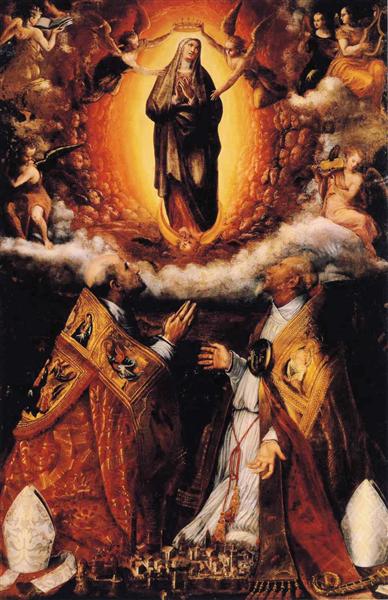
Lavinia was the first female artist whose work was not financed or connected in another way with a court or convent. Sister Plautilla Nelli, who is considered the first-known female Renaissance painter of Florence, was in fact a self-taught nun artist, who was active in the Dominican convent of St. Catherine of Siena in this city. Thus, Lavinia was the audacious groundbreaker who acted as an independent professional artist, regardless of her gender, which in the Middle Ages and the Renaissance Era could have deprived her of liberty and free will. Of course, Prospero’s numerous connections helped his daughter build her great career.
When Lavinia entered the mature stage of her artistic career, her works were admired for her majestic skills, for their vivid color, and for the detail of the outfit and the jewels, which sitters for her portraits wore. Contemporary male writers commended Lavinia for her talents and assessed her in terms of the status of a virtuosa, or an exceptional woman. In her thirties, Fontana was respected as a painter of devotional art. In 1581, she created ‘Jesus Appears to Mary Magdalen’ that is serene, lacking excesses of any kind, either in the construction of forms or in the creation of impressive luministic effects. During the same period, Fontana completed other religious works: the emotionally gripping ‘The Dead Christ with Symbols of the Passion’ and ‘The Holy Family’.
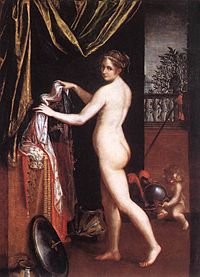
In addition to devotional art, the mature Fontana learned to use her imagination to recreate images from the past. In 1585, she depicted the infamous Egyptian Queen Cleopatra garbed in red and adorned with a jeweled hat and veil, as Cleopatra stands before an urn. In this painting, Fontana achieved the Renaissance era’s immersion in Eastern subjects. The influence of Mannerism is obvious in Fontana’s religious, mythological, and unorthodox works like the painting of Cleopatra, expressed in her high attention to detail and the significance of the materials surrounding the subject.
In 1603, her father, Prospero, passed away. Soon Fontana became a recipient of a rare honor, particularly for a female artist: Pope Clement VIIII summoned her to an audience in the papal palace in Rome and commissioned several works for him. At his request, she executed her most famous public work of the time – a 20-foot altarpiece ‘The Stoning of St. Stephen Martyr”, which pictured the pathos of the first Christian to become a martyr for the true faith. The altarpiece was located at the Church of San Paolo Fuori le Mura, one of Rome’s seven pilgrimage centers, until it was destroyed by fire in 1823, and the painting was lost.” Fontana worked in Rome later: it is astonishing that Popes Gregory XIII and Clement VIII each posed for her in sumptuous ceremonial regalia and offered her commissions normally contracted to male artists.
Fontana was the first female painter to paint female nudes. Her paintings sometimes include nude figures or are centered on them, which was revolutionary for her time as it was unacceptable and unbelievably bold for female artists to do what was not done for many centuries. Her nudes appear as classical figures like Goddess Venus and Minerva. It is incredible: she received commissions for altarpieces and religious art projects from popes and rich people, and she also painted nudes despite being a woman. One of her last and famed paintings featuring nudes was ‘Minerva Dressing’ created in Rome in 1613.

In 1611, when Fontana was again in Rome, the Italian sculptor Felice Antonio Cassoni cast a medal to honor her contribution to the arts. The obverse pictures her in profile. The reverse portrays her as the symbolic female artist: clothed in a loosely draped gown and a chain around her neck, her mouth covered by a band and her hair fluttering wildly, Lavinia is seated at her easel, painting with her right hand, and holding a matchstick in her left hand. This shows her utter dedicated to her work that even prevents her from taming her flowing hair. It was a great honor and accomplishment that Lavinia earned membership in the prestigious Roman Academy.
All images are in the public domain.
Text © 2019 Olivia Longueville

